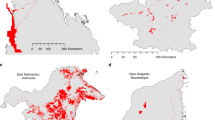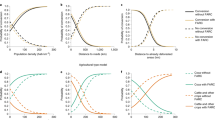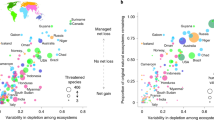Abstract
International commitments for ecosystem restoration add up to one-quarter of the world’s arable land. Fulfilling them would ease global challenges such as climate change and biodiversity decline but could displace food production and impose financial costs on farmers. Here, we present a restoration prioritization approach capable of revealing these synergies and trade-offs, incorporating ecological and economic efficiencies of scale and modelling specific policy options. Using an actual large-scale restoration target of the Atlantic Forest hotspot, we show that our approach can deliver an eightfold increase in cost-effectiveness for biodiversity conservation compared with a baseline of non-systematic restoration. A compromise solution avoids 26% of the biome’s current extinction debt of 2,864 plant and animal species (an increase of 257% compared with the baseline). Moreover, this solution sequesters 1 billion tonnes of CO2-equivalent (a 105% increase) while reducing costs by US$28 billion (a 57% decrease). Seizing similar opportunities elsewhere would offer substantial contributions to some of the greatest challenges for humankind.
This is a preview of subscription content, access via your institution
Access options
Access Nature and 54 other Nature Portfolio journals
Get Nature+, our best-value online-access subscription
$29.99 / 30 days
cancel any time
Subscribe to this journal
Receive 12 digital issues and online access to articles
$119.00 per year
only $9.92 per issue
Buy this article
- Purchase on Springer Link
- Instant access to full article PDF
Prices may be subject to local taxes which are calculated during checkout



Similar content being viewed by others
Data availability
The datasets generated during the current study are available from the corresponding author upon reasonable request. A free online platform for integrated land-use planning including these datasets will be available at www.iis-rio.org/ilup from 2019.
Change history
23 April 2020
An amendment to this paper has been published and can be accessed via a link at the top of the paper.
References
United Nations Sustainable Development Goals (United Nations, accessed 17 November 2017); http://www.un.org/sustainabledevelopment/sustainable-development-goals/
Griggs, D. et al. Sustainable development goals for people and planet. Nature 495, 305–307 (2013).
Chazdon, R. L. et al. A policy‐driven knowledge agenda for global forest and landscape restoration. Conserv. Lett. 10, 125–132 (2017).
Chazdon, R. L. et al. Carbon sequestration potential of second-growth forest regeneration in the Latin American tropics. Sci. Adv. 2, e1501639 (2016).
Crouzeilles, R. Ecological restoration success is higher for natural regeneration than for active restoration in tropical forests. Sci. Adv. 3, e1701345 (2017).
Verdone, M. & Seidl, A. Time, space, place, and the Bonn Challenge global forest restoration target. Rest. Ecol. 25, 903–911 (2017).
Smith, P. et al. How much land-based greenhouse gas mitigation can be achieved without compromising food security and environmental goals? Glob. Change Biol. 19(8), 2285–2302 (2013).
Gourevitch, J. D. et al. Optimizing investments in national-scale forest landscape restoration in Uganda to maximize multiple benefits. Environ. Res. Lett. 11, 114027 (2016).
Zwiener, V. P. et al. Planning for conservation and restoration under climate and land use change in the Brazilian Atlantic Forest. Divers. Distrib. 23, 955–966 (2017).
Strassburg, B. B. N. et al. Moment of truth for the Cerrado hotspot. Nat. Ecol. Evol. 1, 0099 (2017).
Pouzols, F. M. et al. Global protected area expansion is compromised by projected land-use and parochialism. Nature 516, 383–386 (2014).
Possingham, H. P., Bode, M. & Klein, C. J. Optimal conservation outcomes require both restoration and protection. PLoS Biol. 13, 1–15 (2015).
Laurance, W. F. Conserving the hottest of the hotspots. Biol. Conserv. 142, 1137 (2009).
Mittermeier, R. A. et al. Hotspots Revisited: Earth’s Biologically Richest and Most Endangered Terrestrial Ecoregions (Conservation International, 2004).
Latawiec et al. Creating space for large‐scale restoration in tropical agricultural landscapes. Front. Ecol. Env. 13, 211–218 (2015).
Beyer, H. L., Dujardin, Y., Watts, M. E. & Possingham, H. P. Solving conservation planning problems with integer linear programming. Ecol. Model. 328, 14–22 (2016).
Thomas, C. D. et al. Extinction risk from climate change. Nature 427, 145–148 (2004).
Strassburg et al. Impacts of incentives to reduce emissions from deforestation on global species extinctions. Nat. Clim. Change 2, 350–355 (2012).
Crouzeilles, R. & Curran, M. Which landscape size best predicts the influence of forest cover on restoration success? A global meta-analysis on the scale of effect. J. Appl. Ecol. 53, 440–448 (2016).
Crouzeilles, R., Beyer, H. L., Mills, M., Grelle, C. E. V. & Possingham, H. P. Incorporating habitat availability into systematic planning for restoration: a species-specific approach for Atlantic Forest mammals. Divers. Distrib. 21, 1027–1037 (2015).
Groeneveld, J. et al. The impact of fragmentation and density regulation on forest succession in the Atlantic rain forest. Ecol. Model. 220, 2450–2459 (2009).
Soares-Filho, B. et al. Cracking Brazil’s forest code. Science 344, 363–364 (2014).
Kennedy, C. M. et al. Bigger is better: improved nature conservation and economic returns from landscape-level mitigation. Sci. Adv. 2, e1501021 (2016).
Duffy, J. E., Godwin, C. M. & Cardinale, B. J. Biodiversity effects in the wild are common and as strong as key drivers of productivity. Nature 549, 261–264 (2017).
Scarano, F. R. Ecosystem-based adaptation to climate change: concept, scalability and a role for conservation science. Perspect. Ecol. Conserv. 15, 65–73 (2017).
Brancalion, P. H. S., Viani, R. A. G., Strassburg, B. B. N. & Rodrigues, R. R. Finding the money for tropical forest restoration. Unasylva 63, 239 (2012).
Mitchell, M. G. E. et al. Reframing landscape fragmentation’s effects on ecosystem services. Trends Ecol. Evol. 30, 190–198 (2015).
Banks-Leite, C. et al. Using ecological thresholds to evaluate the costs and benefits of set-asides in a biodiversity hotspot. Science 345, 1041–1045 (2014).
PLANAVEG: The National Vegetation Recovery Plan Federal Decree No. 8.972/2017 (Brazilian Ministry of Environment, 2017).
Lemes, P., Melo, A. S. & Loyola, R. D. Climate change threatens protected areas of the Atlantic Forest. Biodivers. Conserv. 23, 357–368 (2014).
Global Biodiversity Information Facility Database (GBIF, accessed 15 March 2017); www.gbif.org
SpeciesLink (SpeciesLink, accessd 15 March 2017); http://splink.cria.org.br/
Oliveira-Filho, A. T. NeoTropTree, Flora Arbórea da Região Neotropical: Um Banco de Dados Envolvendo Biogeografia, Diversidade e Conservação (Universidade Federal de Minas Gerais, 2017); http://www.neotroptree.info/
Flora do Brasil 2020 Under Construction (Jardim Botânico do Rio de Janeiro, accessed 20 March 2017); http://floradobrasil.jbrj.gov.br/
Carvalho, G. Package ‘flora’ 2016: Tools for Interacting with the Brazilian Flora 2020 R Package Version 0.3.0 (R Foundation for Statistical Computing, 2017); https://cran.r-project.org/web/packages/flora/flora.pdf
Robertson, T. et al. The GBIF integrated publishing toolkit: facilitating the efficient publishing of biodiversity data on the internet. PLoS ONE 9, 102623 (2014).
Stotz, D. F., Fitzpatrick, J. W., Parker, T. A. III. & Moskovits, D. K. Neotropical Birds: Ecology and Conservation. (Univ. Chicago Press, Chicago, 1996).
Hijmans, R. J., Cameron, S. E., Parra, J. L., Jones, P. G. & Jarvis, A. Very high resolution interpolated climate surfaces for global land areas. Int. J. Climatol. 25, 1965–1978 (2005).
Jones, P. G. & Thornton, P. K. Generating downscaled weather data from a suite of climate models for agricultural modelling applications. Agric. Syst. 114, 1–5 (2013).
Dormann, C. F. et al. Collinearity: a review of methods to deal with it and a simulation study evaluating their performance. Ecography 36, 27–46 (2013).
Cruz-Cárdenas, G., López-Mata, L., Villaseñor, J. L. & Ortiz, E. Potential species distribution modelling and the use of principal component analysis as predictor variables. Rev. Mex. Biodivers. 85, 189–199 (2014).
Allouche, O., Tsoar, A. & Kadmon, R. Assessing the accuracy of species distribution models: prevalence, kappa and the true skill statistic (TSS). J. Appl. Ecol. 43, 1223–1232 (2006).
Barbet‐Massin, M., Jiguet, F., Albert, C. H. & Thuiller, W. Selecting pseudo‐absences for species distribution models: how, where and how many? Methods Ecol. Evol. 3, 327–338 (2012).
Barve, N. et al. The crucial role of the accessible area in ecological niche modelling and species distribution modelling. Ecol. Model. 222, 1810–1819 (2011).
Stokland, J. N., Halvorsen, R. & Støa, B. Species distribution modelling-effect of design and sample size of pseudo-absence observations. Ecol. Model. 222, 1800–1809 (2011).
Araújo, M. B. & New, M. Ensemble forecasting of species distributions. Trends Ecol. Evol. 22, 42–47 (2007).
Sánchez-Tapia, A. et al. Model-R: a framework for scalable and reproducible ecological niche modeling. In High Performance Computing Fourth Latin American Conference, CARLA 2017. Comm. Comp. Inform. Sci. 796, 218–232 (2017).
Lang, D. T. et al. XML: Tools for Parsing and Generating XML within R and S-Plus R Package Version 3.98-1.1 (R Foundation for Statistical Computing, 2013); https://rdrr.io/cran/XML/
Hijmans, R. J., Phillips, S., Leathwick, J. & Elith, J. dismo: Species Distribution Modeling R Package Version 1.1-4 (R Foundation for Statistical Computing, 2016); https://cran.r-project.org/web/packages/dismo/index.html
Bivand, R., Keitt, T. & Rowlingson, B. rgdal: Bindings for the Geospatial Data Abstraction Library R Package Version 0.8-16 (R Foundation for Statistical Computing, 2014); https://cran.r-project.org/web/packages/rgdal/index.html
Becker, R., Wilks, A., Brownrigg, R., Minka, T. & Deckmyn, A. maps: Draw Geographical Maps R Package Version 3.1. 0 (R Foundation for Statistical Computing, 2016); https://cran.r-project.org/web/packages/maps/index.html
Bivand, R. & Rundel, C. rgeos: Interface to Geometry Engine-Open Source (GEOS) R Package Version 0.3-8 (R Foundation for Statistical Computing, 2014); https://cran.r-project.org/web/packages/rgeos/index.html
Liaw, A. & Wiener, M. Classification and regression by randomforest. R News 2, 18–22 (2002).
Meyer, D., Dimitriadou, E., Hornik, K., Weingessel, A. & Leisch F. e1071: Misc Functions of the Department of Statistics (e1071) R Package Version 1–6 (R Foundation for Statistical Computing, 2014); https://rdrr.io/rforge/e1071/
Poorter, L., Bongers, F. & Rozendall, D. M. A. Biomass resilience of Neotropical secondary forests. Nature 530, 211–214 (2016).
TNC Maps (The Nature Conservancy, accessed 21 October 2016); http://maps.tnc.org/gis_data.html
WorldClim - Global Climate Data (WorldClim, accessed 27 October 2016); http://www.worldclim.org/current
Chave, L. et al. Improved allometric models to estimate the above ground biomass of tropical trees. Glob. Change Biol. 20, 3177–3190 (2014).
Mendes, M. S. et al. Look down—there is a gap—the need to include soil data in Atlantic Forest restoration. Restor. Ecol. https://doi.org/10.1111/rec.12875 (2018).
Sanderman, J., Tomislav, H. & Gregory, J. F. Soil carbon debt of 12,000 years of human land use. Proc. Natl Acad. Sci. USA 114, 9575–9580 (2017).
Ministério do Meio Ambiente Potencial de Regeneração Natural da Vegetação no Brasil (World Resources Institute: Brasil, Brasília, 2017).
Anuário da Agricultura Brasileira: Agrianual 2015 (Informa Economics FNP, São Paulo, 2014).
Chazdon, R. L. Beyond deforestation: restoring forests and ecosystem services on degraded lands. Science 320, 1458–1460 (2008).
Holl, H. D. & Aide, T. M. When and where to actively restore ecosystems? Forest Ecol. Manag. 261, 1558–1563 (2011).
SOS Mata Atlântica & INPE Atlas dos Remanescentes Florestais da Mata Atlântica - Período de 2011 (Fundação SOS Mata Atlântica, São Paulo, 2012); mapas.sosma.org.br
Acknowledgements
The authors acknowledge the support and inputs from the Brazilian Ministry of the Environment, the Secretariat of the Convention of Biological Diversity and experts from the Intergovernmental Science—Policy Platform on Biodiversity and Ecosystem Services (IPBES). B.B.N.S. acknowledges that this work was supported by the Serrapilheira Institute (grant number Serra-1709-19329). B.B.N.S., R.C., A.I. and A.L. acknowledge the support of the German Ministry of the Environment’s International Climate Initiative. R.L. thanks the CNPq (grant number 308532/2014-7) and the O Boticário Group Foundation for Nature Protection (grant number PROG_0008_2013). F.B., M.F.S. and A.S.T. thank CNPq (grant numbers 441929/2016-8 and 461572/2014-1). M.F.S. and A.S.T. thank CAPES (grant number 88887.145924/2017-00). The authors also acknowledge the support of I. L. Lucas in the preparation of the final version of the manuscript.
Author information
Authors and Affiliations
Contributions
B.B.N.S. conceived the study, coordinated the development of the multicriteria approach and wrote the first version of the paper. H.L.B., B.B.N.S., R.C. and A.I. led the optimization modelling, while M.F.S., F.B. and A.S.-T. developed the environmental niche modelling. B.B.N.S., H.L.B., R.C., A.I., M.M., H.P.P., F.B., M.F.S., A.B., J.B.B.S., P.H.S.B., R.L.C., A.G., A.L., J.P.M., R.R.R., C.A.M.S., F.R.S., L.T., T.A.G. and M.U. developed the multicriteria prioritization approach. R.L., J.P.M. and A.O.F. contributed biodiversity data, and R.L.C. and E.N.B. developed the climate mitigation surface. C.A.M.S. coordinated the interface with policy applications. All authors analysed the results and provided input into subsequent versions of the manuscript.
Corresponding author
Ethics declarations
Competing interests
The authors declare no competing interests.
Additional information
Publisher’s note: Springer Nature remains neutral with regard to jurisdictional claims in published maps and institutional affiliations.
Supplementary information
Supplementary Information
Supplementary Figures 1–10, and Supplementary Tables 1 and 2
Rights and permissions
About this article
Cite this article
Strassburg, B.B.N., Beyer, H.L., Crouzeilles, R. et al. Strategic approaches to restoring ecosystems can triple conservation gains and halve costs. Nat Ecol Evol 3, 62–70 (2019). https://doi.org/10.1038/s41559-018-0743-8
Received:
Accepted:
Published:
Issue Date:
DOI: https://doi.org/10.1038/s41559-018-0743-8
This article is cited by
-
Nature-based solutions potential for flood risk reduction under extreme rainfall events
Ambio (2024)
-
Forecasting natural regeneration of sagebrush after wildfires using population models and spatial matching
Landscape Ecology (2023)
-
Priority areas and benefits of ecosystem restoration in Beijing
Environmental Science and Pollution Research (2023)
-
Relocating croplands could drastically reduce the environmental impacts of global food production
Communications Earth & Environment (2022)
-
Estimates of regeneration potential in the Pannonian sand region help prioritize ecological restoration interventions
Communications Biology (2022)



